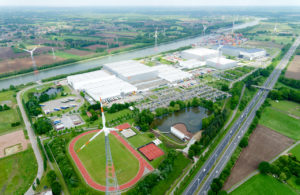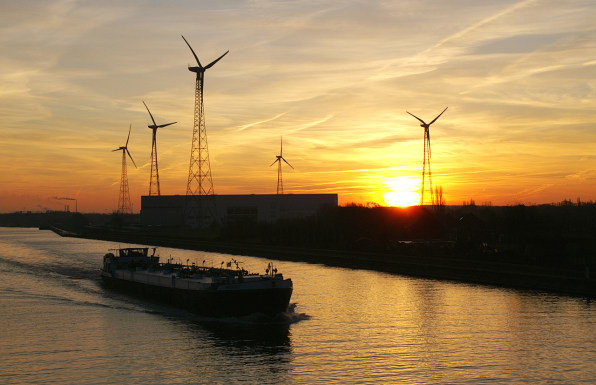Source: fastcompany.com
Published: July 3, 2016

Simon Schmitt
Most of the deliveries arrive directly by boat, the cranes are all hybrids, and it runs on 100% renewable energy.
At a typical distribution center somewhere next to a midwestern highway, an endless series of trucks lines up next to a massive, energy-sucking warehouse. At Nike’s new distribution center in Europe, things are different: Incoming shipments arrive by canal, and the entire operation runs on renewable energy.
The expanded center, centrally located in Belgium, is surrounded by six huge wind turbines–producing enough electricity to power 5,000 houses–and covered in solar panels over an area the size of three soccer fields. A thermal energy system stores warm water in the summer to heat the building in the winter, and the opposite when the seasons change.
As much as possible, the center avoids using trucks to help lower the carbon footprint of transportation. More than 95% of incoming goods arrive on boats, helping avoid 14,000 truck journeys a year (by carrying multiple containers, boats are automatically more efficient). For deliveries to consumers, because the canal system generally takes too much time, the company often uses trains instead of trucks.
“We have optimized our logistics processes and transport routes to balance the needs for reducing our environmental impact while ensuring we reach consumers in a timely way,” says Bert Stevens, vice president of supply chain operations for Nike Europe.
Even employee transportation is as sustainable as possible; anyone who commits to bike to work at least half of the time is given a free bike. (Employees who live more than 15 kilometers away get a free electric bike.)

Inside the center, hybrid cranes work like hybrid cars, generating energy when they slow down, which then powers other cranes and conveyors. Large windows provide natural light, and an experimental “daylight delivery system” captures sunlight in fiber optic cables, carrying it to the few parts of the building that don’t have windows.
When Nike decided to expand their existing distribution center, they measured the biodiversity of the area and designed a plan to increase it. Green roofs and green walls attract birds and insects, and beehives and flowers attract bees. Sheep maintain the lawn instead of lawn mowers.
The company initially considered going even further and covering the roof in trees but ran into issues with weight. “Instead we lined both the rooftops and walls of the facility with smaller vegetation, which helps to insulate the building, provide habitats for increasing biodiversity, and, through the buffering of water, protect against flooding,” says Stevens.
Nike sees it as a model for the rest of its supply chain. “We are incredibly proud of what we’ve accomplished here in Europe,” says Eric Sprunk, Nike’s chief operating officer. “We will take best practices and learnings from [the center] and apply them where relevant, as we continue to drive toward the supply chain of the future globally.”
